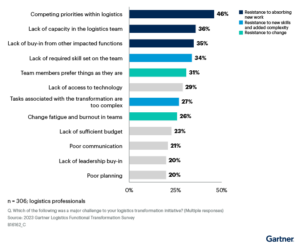A recent survey by Gartner has revealed 76% of logistics transformations fail to meet essential performance metrics. This high failure rate encompasses missed budgets, extended timelines and unmet key performance indicators. However, the research highlighted a promising solution: leaders who effectively respond to team resistance and incorporate feedback can improve their success rates by 62%.
“Leaders often respond to resistance by ramping up urgency and adopting a directive leadership style, which is not only ineffective but actually counterproductive,” said Snigdha Dewal, senior principal researcher at Gartner’s Supply Chain practice. “Instead, leaders should engage their teams from the start, embrace resistance as a resource, and act on feedback to adapt their plans. Harvesting the collective wisdom of their teams can lead to dramatically improved odds of success.”
Gartner’s survey, conducted from November to December 2023, involved 306 logistics professionals from organisations with US$500 million (c. £393m) or more in annual revenues. The findings revealed that over 80% of respondents had attempted four transformations in fewer than five years, averaging nearly one per year. Internal resistance was identified as a more significant obstacle than external pressures in these initiatives (see Figure 1).

Additionally, the survey showed that while 81% of logistics leaders believe transformation is critical, only 20% adopted the approach of leveraging resistance as a valuable resource. This method of engaging with team resistance significantly improved the chances of transformation success by 62%.
The prevailing approach, marked by directive leadership and a “get with the programme” mindset, decreased the odds of success by 47%. Gartner’s analysis found that the way organisations communicated and acted towards their teams during transformations had a profound impact on their success rates.
“Resistance can be productive or unproductive,” Dewal explained. “Leaders must shift from viewing resistance as a barrier to seeing it as a source of valuable insights. This approach not only enhances project management outcomes but also boosts staff morale and can help unearth new competitive advantages.”
Key drivers for successful transformations
Gartner’s report emphasised three key drivers behind the successful adoption of this leadership approach:
- Leaders demonstrate listening: while leadership sets the objectives, they remain open-minded to changes based on feedback gathered throughout the process.
- Involvement of resistant stakeholders: engaging the most resistant team members helps to understand the underlying challenges and gauge the team’s overall readiness for change.
- Adaptable leadership mindset: recognising that setbacks are a natural part of transformations and leaders need to focus on mission-critical aspects and view failures as learning opportunities to refine their focus.







